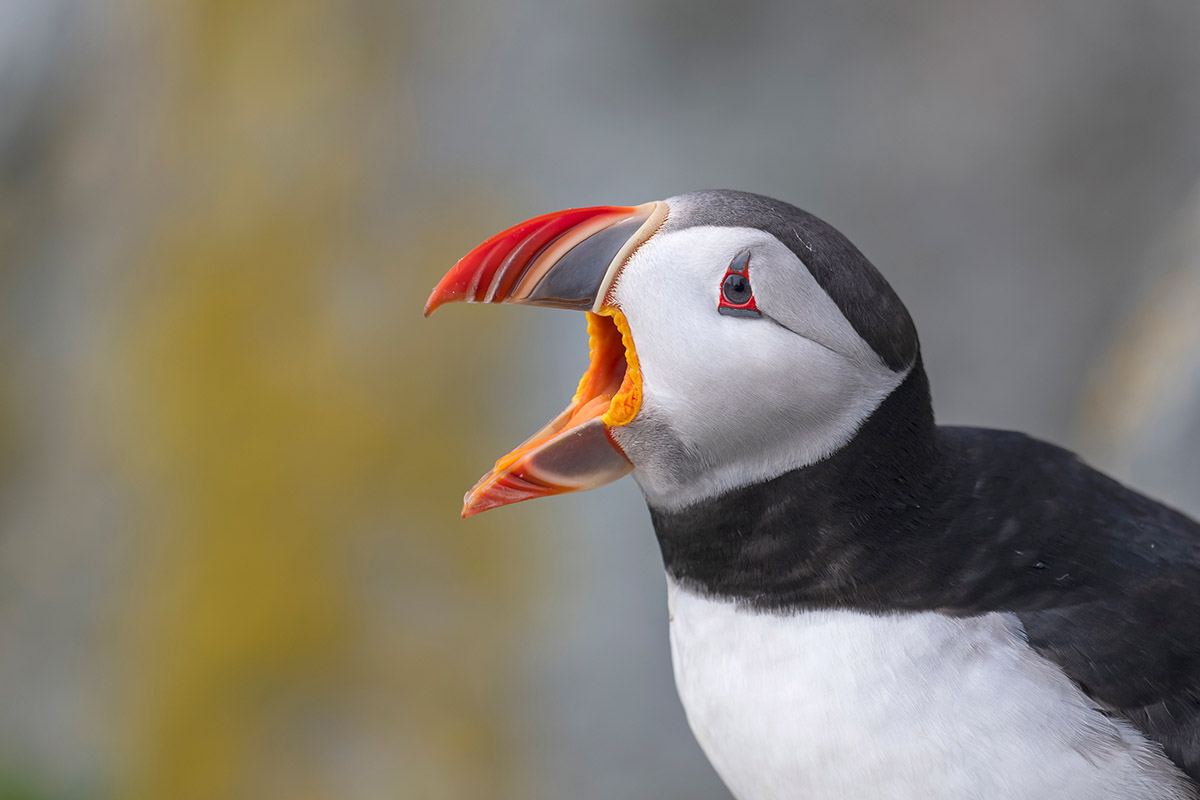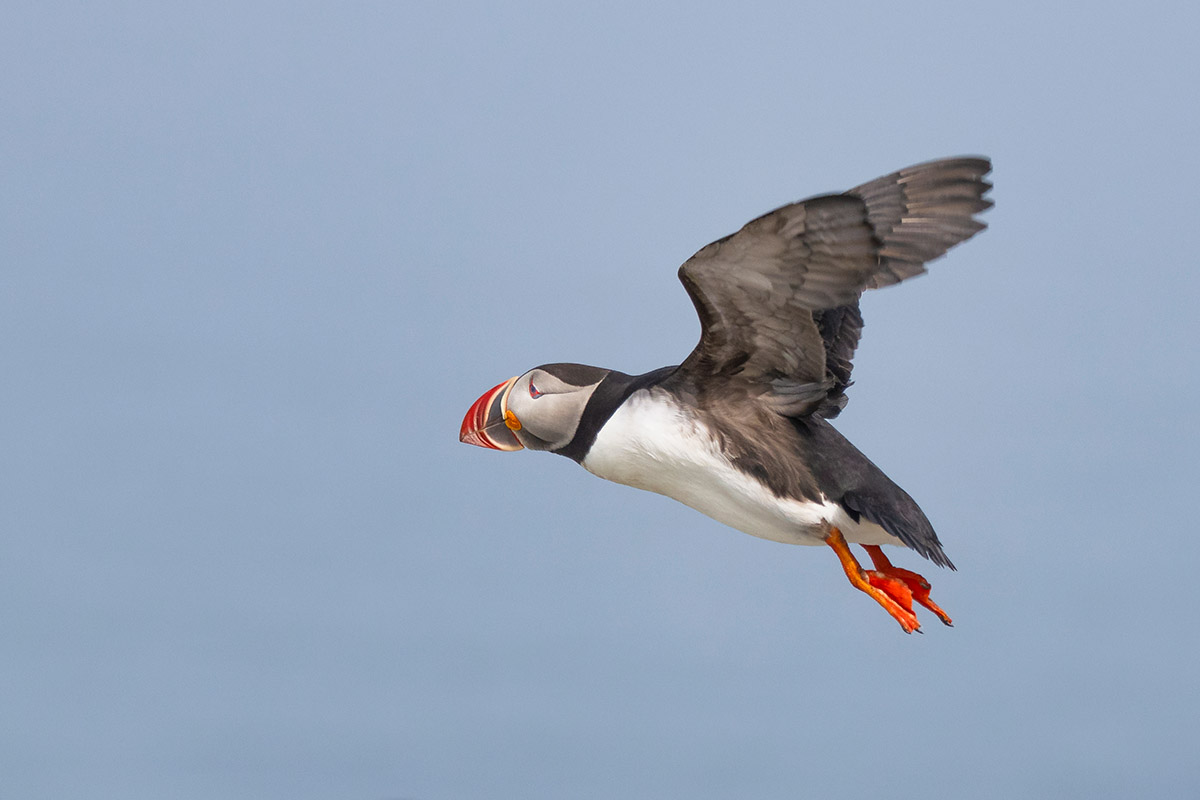
All photos © Robin and Arlene Karpan

Atlantic puffins get our vote as the coolest-looking birds anywhere. They are a treat to see anytime, but this summer we had the rare opportunity to get up close and personal with these magical birds on Machias Seal Island, New Brunswick. It’s the only place in North America where we can land at a puffin colony and spend an hour watching and photographing them from a photography blind.

The trip to Machias Seal Island
The remote island isn’t easy to reach. First, you have to take a 1.5-hour ferry ride from the mainland to Grand Manan Island (that’s the easy part). From there, Sea Watch Tours runs a once per day 5-hour excursion to Machias Seal Island, with most of the time taken up in just travelling there and back. The island is a tightly controlled Canadian Migratory Bird Sanctuary, with only 15 people per day allowed to visit the island. With those restrictions, and a fairly short season from June 25 to July 31, the trips get booked up almost instantly when reservations open in the winter or early spring.

Once on the island, visitors spend an hour in viewing blinds that hold 4 people. Small sliding openings, big enough for a large camera lens, face each direction. How close do the puffins come, you may ask? Close enough that you could almost reach out and touch them, while others dance on the roof of the blind. We’re right in the thick of things.

Other seabirds nest here as well, most notably large numbers of razorbills, but also Leach’s storm petrels, common murres, Arctic terns, and more. While it’s also a great chance to photograph other species, especially razorbills, it’s really the puffins that steal the show. They are constantly scurrying around and flying back and forth, but puffins are so cool that they don’t have to be doing anything to be photogenic.


Photographic equipment
With the birds that close, what photo equipment do you need? This is one place where it is possible to do bird photography without a long telephoto lens. However, we still recommend taking the longest telephoto you have for frame-filling close-up shots. Sometimes the most photogenic bird is one that is further away. On the way back, the trip also passes by North Island, a major seal colony where you need a long lens to catch the action.

Zoom lenses are ideal here, allowing you to quickly change between overview shots and isolate specific birds or even just the bird’s head. We used a 180-600mm zoom on one camera and a 70-200mm zoom on the other. We also had a 20-120mm lens that we used occasionally when the birds were extremely close, although we didn’t use it a lot.

When we looked at our favourite shots, they spanned a variety of focal lengths, so we’re glad we had that range to choose from. Several times a puffin wandered in so close that the 180-600 lens wasn’t able to focus. Forget about bringing a tripod. There isn’t room for it in the crowded blind and you can rest your lens on the window ledge if you need added stability.

We decided to concentrate on close-up shots. There aren’t many places where you can get as close to puffins as you can here. Earlier this summer we also visited Witless Bay Ecological Reserve in Newfoundland, home to the largest puffin colony in North America with a half million birds (this will be the subject of a future post). This is also a trip we highly recommend though it is a very different experience. Visitors are not allowed to land on the nesting islands so you have to photograph from a tour boat. It’s great for overview shots but more difficult to get close-ups. So much depends on sea conditions and how close the boat can get to the cliffs.

On Machias Sea Island, the puffins are right in front of us and practically posing. We had plenty of light so we kept the ISO reasonably low (low for wildlife photography, that is) at around ISO 400-500. The 180-600mm lens has a variable aperture of f/5.6 – 6.3 and the 70-200 lens is f2/8. We used both wide open the entire time. At ISO 400 we could get shutter speeds as high as 1/2000 sec to 1/4000 sec with the 180-600 and up to 1/8000 sec with the 70-200 – plenty fast to stop the action for flying birds. In darker areas, such as the shot of the puffin in its burrow, the shutter speed was as low as 1/200 sec – still fast enough for a bird that wasn’t moving.


If You Go
The first thing is to plan ahead – far ahead – because the trips book up fast. There isn’t a lot of room in the blind to take a bunch of stuff so choose your equipment carefully and stick to one or two lenses that you think will be the most useful. We were fortunate to have plenty of light but this area gets a lot of fog so be prepared to shoot at a considerably higher ISO in low-light conditions. High ISO may mean more noise in the photos but noise can be corrected in processing. That’s still a lot better than getting blurry images because the shutter speed wasn’t high enough to stop the action.

Since Grand Manan Island is the departure point for the trip to Machias Seal Island, be sure to set some time aside to see it as well. It’s a wonderful place with impressive cliffs, nature reserves, great hiking, and picturesque fishing villages.
Resources
For more information on other attractions throughout New Brunswick visit Tourism New Brunswick.
Other articles on New Brunswick on Photojourneys that you might enjoy
- Photographing Puffins on Machias Seal Island
- Dulsing on New Brunswick’s Grand Manan Island
- Two outstanding Bed & Breakfasts in Fredericton
- King’s Landing – A Window to the Past
- Having a Sweet Time in St. Stephen, New Brunswick
- Covered bridges of New Brunswick
- Exploring Cape Enrage
- Saint John, New Brunswick is a Delightful Mix of History and Nature
- St. Martins and the Fundy Trail Parkway
- Minister’s Island – Driving Across the Ocean Floor in New Brunswick
- Kingsbrae Gardens near St. Andrews
Subscribe to Photojourneys below
Feel free to PIN this article on Puffins on Machias Seal Island, New Brunswick for later


